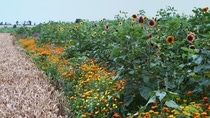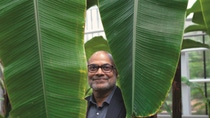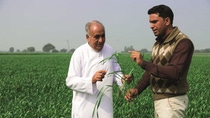Média
High-tech solutions to combat hunger
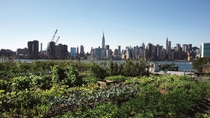
The world’s population is growing, food is becoming scarcer. Without great strides in innovation, the demand for food is likely to outstrip supply. Vertical farming, urban farming, combine harvesters that are analysis laboratories on wheels, and last but not least, the smartphone: therein lie the hopes for the agriculture of the future.
The years of plenty and well-filled granaries are over. World grain reserves, the most fundamental indicator of the world’s ability to feed itself, have dwindled alarmingly in the past ten years. The amount of corn, wheat and rice held in storage in 2013 would have been just enough to meet global demand for 76 days; ten years ago, the figure was 107 days.
Climate change, water shortages, soil erosion and population growth are making it increasingly difficult to grow enough food for all. Agriculture is advancing to become a key industry of the 21st century. A new era of exploding prices and rampant famine is imminent, warns Lester R. Brown in his book Full Planet, Empty Plates. The founder and president of the Earth Policy Institute based in Washington, D.C., is one of the great pioneer environmentalists. “Food is the new oil, land is the new gold,” Brown reckons. He identifies an emerging geopolitics of food in which countries will scramble to protect their own individual interests as best they can.

Land is the new gold
The world is already living beyond its means with one in eight people suffering from chronic hunger. Projections indicate that more than two billion people more will need to be fed by the year 2050. To provide enough food so that – at least in theory – nobody on the planet would have to live with hunger, agricultural production would need to rise by at least 70%1. These United Nations Food and Agriculture Organization (FAO) figures actually understate: animal feed and biofuels are not included in the calculation.
Agriculture is facing a paradigm shift similar to the transition in energy policy. Fertile land is scarce. Desertification is destroying twelve million hectares of arable land every year, an area corresponding to about half of the UK. The demand for arable land is increasing as more people turn to a westernized, meat-based lifestyle – cattle and pigs need feeding too, after all. “No more than 10% of the additional global demand can be met by increasing the amount of land devoted to crops. We need to make up the rest by raising yield,” Dr. Harald von Witzke, Professor of International Agricultural Trade and Development at Humboldt University, Berlin says. Unless we produce our food not only more efficiently but more sustainably too, we will end up depriving ourselves of the natural resources we need to survive.
“Food is the new oil, land is the new gold.”
Lester R. Brown, founder and president of the Earth Policy Institute
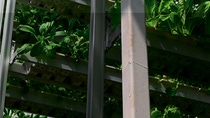
Farming goes vertical
The ‘how’ is not even the biggest problem. “The scarcest resource of all is time,” Lester R. Brown warns. The urgency is suddenly making solutions attractive that many would have considered absurd just a few years ago. In Singapore, where more than five million people are squeezed into an area of 700 square kilometers, farming is gradually shifting to the vertical. In an urban vertical farm run by a company called Sky Greens, spinach, cabbage and lettuce plants rotate in 120 nine-meter-high aluminium shelves to get their place in the sun. Japan, too, is experiencing a veritable boom in similar schemes since the Fukushima nuclear disaster not only ruined tracts of arable land but also compromised public confidence in the quality of local agricultural produce. Spread Co., the largest Japanese vegetable factory, produces 7.3 million heads of lettuce every year in a windowless factory hall that looks more like a hangar than a greenhouse. The plants see neither sun nor soil but grow on floating beds in an aqueous nutrient medium under red and blue LED lights.
Although the 30-story luxury version of a vertical farming skyscraper advocated by Dr. Dickson Despommier ever since the late 1990s has not seen the light of day yet, the retired professor of biology at Columbia University, New York feels vindicated. “In ten years’ time, half of the food produced in Japan will be from plant factories,” Despommier believes. “Vertical farming is not just Japan’s future, either. Other countries will follow suit.” On average, one indoor hectare is roughly equivalent to ten hectares of field, Despommier says. Factory farmed vegetables are untouched by the effects of changing seasons, insect infestation and drought. In fact, the artificial environment teases out the full genetic potential of each grain. What’s more, it takes barely a third of the water and a quarter of the fertilizer. Vegetable factories need no pesticides at all.
However, vegetable factories are only one piece of the puzzle in the fight against global hunger. The extent of their contribution to global food security is mainly a matter of cost, agriculture professor von Witzke says: “Only rich countries will be able to afford the expensive vegetable factories for the time being.”
But for the world to be able to produce enough to feed more and more people, highly efficient vegetable factories are unavoidable. “We are duty-bound to go down this route,” von Witzke says. Production of a mere 1% increase in agricultural resources in the EU in vegetable factories would free up 1.2 million hectares of arable land in other countries that they could use in turn to meet their own food requirements, according to von Witzke’s calculations. This could preserve biodiversity equivalent to 600,000 hectares of tropical rainforest.
“The more real-time information farmers have and the better it is, the more effective their decision-making will be.”
Professor Simon Blackmore, Ph.D., Harper Adams University in Shropshire, England
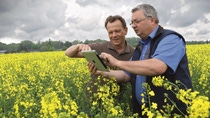
50% better harvests a possibility
However, the professor places his greatest hopes in plant breeding to obtain more resistant crops and tailored crop protection. Even in a highly industrialized agricultural system like Germany’s, yield increases of 50% from sowing to harvest are still feasible, he believes. “The genetic potential of crops is designed even now to enable much higher yields,” von Witzke says. Weather and soil quality are always going to influence harvests, true – but smart agricultural machinery and robots will be able to give each single plant more targeted care in the future.
Ideas for ways to conserve natural resources abound. Camera-assisted sprayers precisely targeted for application to the leaves of plants could contribute to a more efficient use of crop protection agents, says Simon Blackmore, Ph.D., professor at Harper Adams University in Shropshire, England. Other robots attack weeds with laser rays. To avoid the negative effects on the accuracy of the lasers caused by uneven field surfaces, researchers are looking at unmanned agricultural drones. One thing is for sure: Soil that is expected to feed many generations to come needs better protection in future.
Reducing grain crops can help too. BASF is working on new developments in animal feed, which make a sustainable contribution to food production. Adding an enzyme combination to their feed enables poultry and pigs to utilize dietary grain more efficiently. The enzymes break down indigestible polysaccharides and make them fit for digestion; the animals can therefore utilize these components as a source of energy and need less grain as a result.
Ammonia for growth: The legacy of Haber and Bosch
Robots conserve resources
Maximum yield coupled with minimum use of resources: Variety selection, crop protection, fertilization and irrigation can be fine-tuned using modern technology. Data is increasingly becoming a factor of production in addition to land. Nowadays, using the smartest technology is what determines whose harvest turns out best. Simon Blackmore is confident that robotics will have revolutionized agriculture in ten to twenty years’ time. “We badly need new management systems to deal with the new complexity,” Blackmore says. “The more real-time information farmers have and the better it is, the more effective their decisionmaking will be.”
That is precisely what BASF set out to do in cooperation with equipment manufacturer John Deere. Plans for the cross-industry alliance were announced in late 2013. This non-exclusive alliance is based on the joint conviction that the best solutions arise at the interface between specialist agronomic know-how and equipment expertise. Farmers can now use data platforms such as myjohndeere.com to track the real-time whereabouts of their tractors by computer, tablet or smartphone. Equipped with high-tech sensors, modern combine harvester owners know thanks to GPS exactly where the machines are at any given time and can analyze yield quality on every piece of land and take suitable corrective action with pinpoint precision.
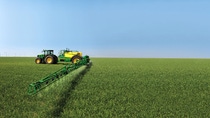
Agricultural machinery gets smart
“Every single square meter of acreage will become a test plot,” Patrick Pinkston, John Deere’s Vice President, Technology and Information Solutions Agriculture and Turf Division says, his enthusiasm evident. Smart agricultural machinery produces enormous data sets – think “big data.” When farmers agree to participate and share their data, BASF’s agronomics experts can use those data sets to generate automated recommendations. As the season progresses, farmers receive increasingly reliable simulations indicating the impact each of their decisions will have on the harvest. The information also helps to unlock more of biology’s secrets, which plant breeders can use in turn for further optimization. “The necessary yield sensor technology has been commercially available for about 10 years already. The aim now is to use the data from these and other sources as a basis for decision-making to raise productivity on a sustainable basis,” explains Dr. Matthias Nachtmann, head of BASF’s agIT project team. BASF plans to advance the development of mobile decision-making tools based on big data with a doubledigit million euro investment.
Unlike high-tech vegetable factories, smart farming gives even the poorest countries the chance of rapid gains. That’s because just one smartphone is sufficient to bring important knowledge into a village. Weather forecasts, for instance, can prevent heavy rainfall from washing freshly sown seed from the fields. Other apps tell farmers the right fertilizer dosage to use. They can also help in diagnosing crop diseases. Brazilian farmers and advisors are already using a BASF tool like this. A photo of the diseased plant helps as a basis for recommending the right crop protectant. A photo can also identify the fertilizer requirement. Developed originally for the British market, the app is now also used by many Indian and Chilean farmers.
Smart farming is not a development from the high-tech niche. A 2013 study identified more than 1,600 IT-supported agricultural tools of this kind. Nachtmann concludes: “Currently available IT tools are failing to meet farmers’ needs. Farmers stand to benefit enormously from integrated solutions in the future.”
Food and Agriculture Organization of the United Nations, Save and Grow, as of July 2014

